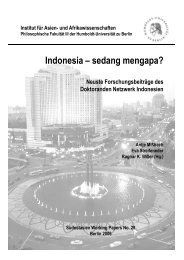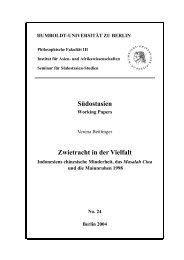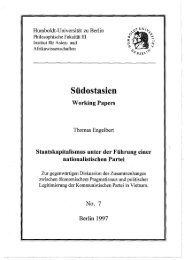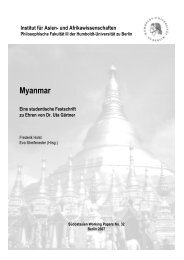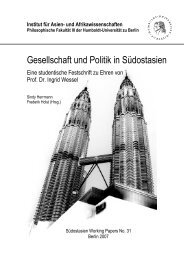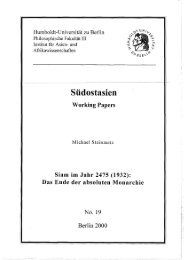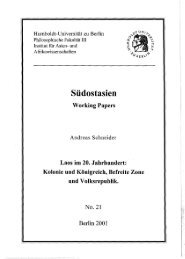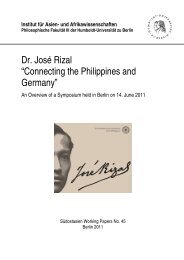On Centrism and Dualism - Humboldt-Universität zu Berlin
On Centrism and Dualism - Humboldt-Universität zu Berlin
On Centrism and Dualism - Humboldt-Universität zu Berlin
You also want an ePaper? Increase the reach of your titles
YUMPU automatically turns print PDFs into web optimized ePapers that Google loves.
CENTRISM AND DUALISM<br />
Figure 1. Schematized model of generalized/asymmetric exchange<br />
P<br />
U<br />
P<br />
U<br />
Z<br />
Z<br />
A. Flow of women B. Flow of goods <strong>and</strong> services<br />
What, now, is ‘generalized exchange’ It is, in fact, a system in which, between two defined<br />
‘partners’, exchange is no longer reciprocal, but unilateral or oriented […]. In order for the system<br />
to be viable, it is obviously necessary for the chain to be closed, i.e. the first giver in the chain, P,<br />
receives from another partner, let us say Z. This is what Dutch authors working on Indonesia<br />
called ‘circulating connubium’ […] while restricted exchange corresponds to marriage between the<br />
bilateral cross cousin, generalised exchange corresponds exclusively to marriage with the<br />
matrilateral cross cousin (mother’s brother’s daughter) (DUMONT 2006: 71 [1971]).<br />
According to RUBEL <strong>and</strong> ROSMAN, LÉVI-STRAUSS’ three structural models are assigned to two<br />
categories, viz. restricted <strong>and</strong> generalized exchange, in which the category of generalized<br />
exchange includes two models: one based on the marriage of the patrilateral cross-cousin <strong>and</strong><br />
the other, based on the marriage of the matrilateral cross-cousin.<br />
In my argument I follow Chris GREGORY (1994: 925-927), who presents a refined perception<br />
of these structural models of affinal exchange, where the latter type (MBD marriage), together<br />
with restricted exchange (bilateral cross-cousin exchange), are understood as constituting the<br />
two extreme forms of affinal alliance in which the flow of women is fixed over generations,<br />
<strong>and</strong> hence represent the means by which inter-group solidarity is attained.<br />
Nevertheless, these two forms fix the flow of women in contrasting ways. In the case of<br />
generalized/asymmetric exchange, with matrilateral cross-cousin marriage, women flow<br />
exclusively in one direction between any two alliance-groups, whereas in the case of<br />
restricted/symmetric exchange women are given <strong>and</strong> reciprocally received between the same<br />
groups – they flow in both directions simultaneously.<br />
<strong>On</strong> the structural level, marriage with the patrilateral cross-cousin may be understood as an<br />
intermediate form, constituting what GREGORY calls delayed exchange (ibid.: 926), or in the<br />
words of LÉVI-STRAUSS it “expresses discontinuity” (LÉVI-STRAUSS 1993: 599 [1969]). In<br />
this special case 50 the direction of exchange gets reversed rather than repeated in each<br />
50 “[…] but of all the three forms it is the least attested, yet the most discussed […] “(DUMONT 2006: 79 [1971]).<br />
26



